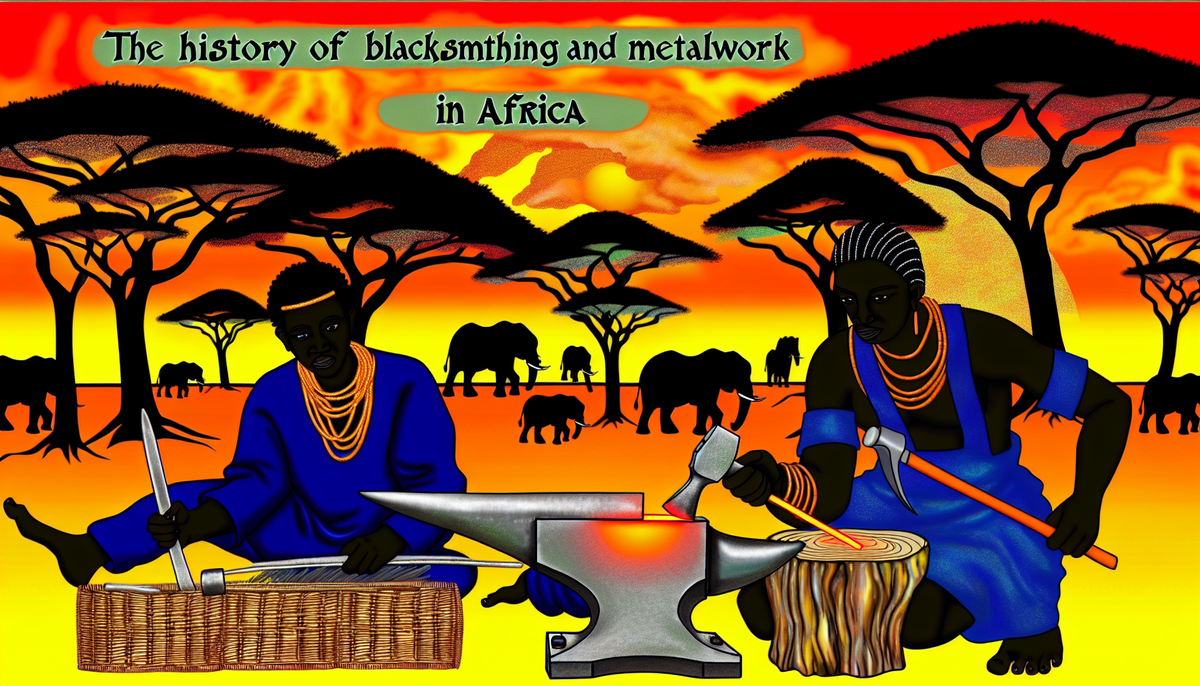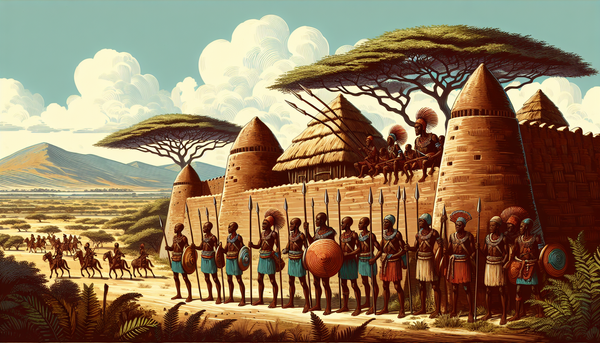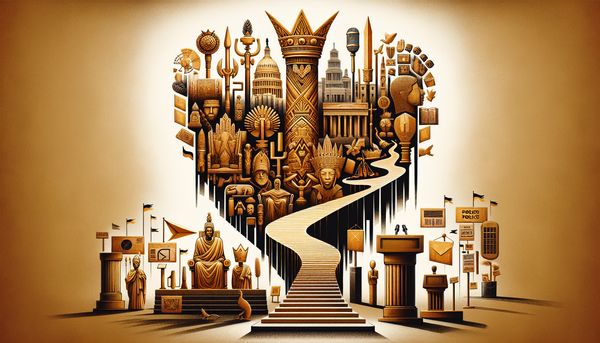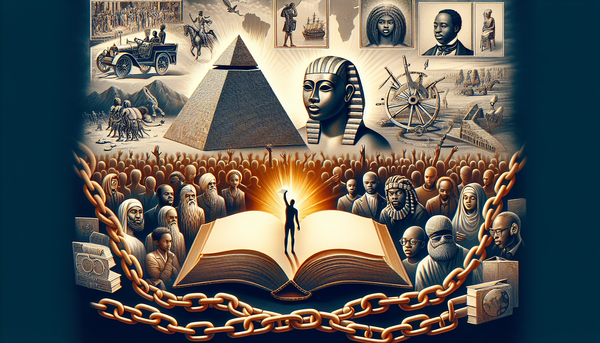The History of Blacksmithing and Metalwork in Africa

Introduction to African Blacksmithing Traditions
Blacksmithing is a profound and ancient craft with deep roots in African culture, integral to the continent's technological and artistic development. Originating thousands of years ago, this tradition involves the forging of metals, primarily iron, into tools, weapons, and decorative items. The art reflects not only the skill of the blacksmith but also the complexities of African societies, economies, and spiritual beliefs.
In many communities, blacksmiths held esteemed positions as craftspeople and cultural custodians, often revered for their ability to manipulate the raw elements of earth into functional and artistic forms. Traditional blacksmithing techniques, passed down through generations, vary significantly across the continent, influenced by local resources and cultural practices.
Regional variations showcase distinct styles and uses of metals, such as the intricate goldsmithing of West Africa and the resilient iron tools crafted by East African blacksmiths. These practices are not merely utilitarian; they carry symbolic meanings and play a crucial role in rituals, marriage ceremonies, and community identity. Thus, African blacksmithing embodies a rich tapestry of tradition, innovation, and heritage that continues to evolve in contemporary society.
Tools and Techniques of Ancient Metalwork
Ancient African metalwork was characterized by a diverse range of tools and techniques, each reflecting the ingenuity of local artisans. At the heart of these crafts was the forge, a vital structure powered by charcoal or wood, where metals were heated until malleable. The primary metal worked was often iron, although gold and copper were also used for ornamental and ceremonial purposes.
Blacksmiths employed various hand tools, including hammers, tongs, anvils, and chisels, each serving specific functions in shaping and detailing their creations. The hammer, typically made from hard metals, was essential for striking and forming pieces on the anvil. Tongs allowed the smith to manipulate hot metal safely, while chisels were used for engraving intricate patterns or designs.
Techniques such as smelting and forging were pivotal in the production of metal artifacts. Smelting involved extracting metal from its ore, often utilizing clay or stone furnaces designed for high temperatures. Forging required skillful application of heat and force to shape the metal accurately. Additionally, methods like casting and welding were also employed to create more complex shapes and join different metal pieces.
Together, these tools and techniques highlight the remarkable craftsmanship and technological advancements of ancient African metalworkers, whose legacies still influence contemporary practices.
Influential African Metalsmiths of the Past
Throughout history, numerous African metalsmiths have made significant contributions to the craft, influencing both local and global perceptions of metalworking. One prominent figure is the ancient African blacksmith known as the "Nguni" smith, who played a vital role in shaping iron-working traditions in Southern Africa. Renowned for their craftsmanship, these smiths produced exceptional tools and weapons, essential for agrarian societies and defense.
In West Africa, the legendary blacksmiths of the Nok culture, dating back to around 1000 BCE, are celebrated for their advanced techniques in ironworking and their intricate terracotta sculptures. Their artistry laid the foundation for metallurgy in regions like Nigeria, impacting subsequent generations of artisans.
Another notable figure is the blacksmiths of the Mali Empire, especially during the reign of Mansa Musa in the 14th century. They were known not only for creating utilitarian objects but also for crafting ornate jewelry and decorations that symbolized wealth and status.
Furthermore, the Hausa people of Nigeria produced influential metalworkers renowned for their skills in decorative ironwork, innovative tools, and weapons. These artisans helped shape regional trade networks and contributed to the rich artistic legacy of Africa, demonstrating the profound impact of metalsmiths on culture and society.
Iconic Metalwork Pieces from Various Regions
African metalwork is celebrated for its diversity and artistry, producing iconic pieces that reflect the cultural heritage of various regions. One notable example is the famous bronze sculptures from the Benin Kingdom in present-day Nigeria. Crafted by skilled artisans, these intricate reliefs and figures were used to adorn the royal palace and depicted historical events, significant figures, and religious themes, showcasing the elite craftsmanship of the kingdom.
In West Africa, the Kola nut box, often intricately crafted from silver or brass, serves as a ceremonial object symbolizing hospitality and friendship. These beautifully designed boxes, adorned with traditional motifs, highlight the artistry of the makers while underscoring the cultural importance of the Kola nut in social rituals.
Moving east, the Swahili Coast's metalwork features striking jewelry made from gold, silver, and copper. The intricately designed bracelets and necklaces often embody the fusion of Islamic and African artistic influences, representing identity and status among the coastal communities.
The iconic iron swords and weapons from regions like the Mandé of West Africa are also noteworthy. Their functional design combined with artistic flourishes illustrates the dual purpose of practical use and artistry, embodying the rich heritage of metalworking across the continent. These pieces remain testaments to the creativity and skill of African metalsmiths throughout history.
Impact of Blacksmithing on African Cultures
Blacksmithing has had a profound impact on African cultures, shaping social structures, economies, and spiritual practices across the continent. As skilled artisans, blacksmiths held revered statuses within their communities, often viewed as custodians of knowledge and tradition. Their ability to transform raw ores into functional tools and intricate art pieces contributed significantly to agricultural productivity and warfare, thereby influencing the power dynamics within societies.
The economic significance of blacksmithing cannot be overstated. The creation of tools like plows and sickles facilitated agricultural expansion, leading to increased food production and trade. Metalworkers also produced weapons that empowered communities in defending their territories, which further solidified the role of blacksmiths as vital contributors to societal stability and growth.
Moreover, blacksmithing is deeply intertwined with African spirituality and symbolism. Many communities associate metalwork with ancestral connections, believing that blacksmiths possess a unique relationship with the spirit world. Rituals and ceremonies often incorporate metal artifacts, emphasizing their cultural importance and spiritual significance.
Overall, blacksmithing has not only fostered practical advancements in daily life but has also woven itself into the fabric of identity, tradition, and community, highlighting the indispensable role of this craft in influencing African cultural heritage.
Modern Developments in African Metalworking Practices
In contemporary Africa, metalworking practices have evolved significantly, embracing both traditional techniques and modern technologies. Artisans are increasingly incorporating innovative methods and materials to meet the demands of a global market while preserving cultural heritage. The fusion of ancient craftsmanship with modern machinery has led to the production of high-quality metalwork that appeals to both local and international audiences.
One notable trend is the resurgence of interest in traditional metalworking skills among younger generations. Many artisans are reclaiming ancestral techniques, such as lost-wax casting and hand-forging, while integrating contemporary design elements. This blend of old and new allows for a vibrant artistic expression, resulting in unique pieces that resonate with a broader audience.
Moreover, the rise of sustainability in metalworking is shaping modern practices. Artisans are increasingly focusing on eco-friendly methods, utilizing recycled materials and minimizing waste in their production processes. This shift not only addresses environmental concerns but also promotes community-based economies.
Additionally, workshops and initiatives are emerging across the continent to train a new wave of metalsmiths, ensuring that these invaluable skills are passed on effectively. As a result, modern developments in African metalworking not only enhance economic opportunities but also foster a renewed appreciation for the rich cultural heritage embedded in the craft.
The Future of Blacksmithing in Africa and Its Global Influence
As we look to the future, blacksmithing in Africa is poised for both exciting developments and challenges that will influence the global metalworking landscape. The increasing integration of technology, such as computer-aided design (CAD) and 3D printing, offers new opportunities for African blacksmiths to innovate. These tools can enhance precision and efficiency, allowing artisans to create complex designs that blend traditional techniques with modern aesthetics.
Moreover, the resurgence of the handmade movement, emphasizing sustainability and artisan craftsmanship, is creating a market for African metalwork on the global stage. Consumers are increasingly seeking unique, ethical products, leading to a burgeoning demand for traditional African metal artifacts that tell a story and celebrate cultural heritage.
Educational initiatives and workshops are essential for preserving traditional skills and ensuring they are passed down to future generations. As more young artisans engage in blacksmithing, they will continue to evolve the craft, incorporating new materials and trends while maintaining cultural significance.
Additionally, collaborations between African blacksmiths and global designers can foster cross-cultural exchanges, enriching the craft further. This synergy not only showcases Africa’s rich metallurgical heritage but also positions African blacksmithing as a significant contributor to the global artisan market, fostering appreciation for diverse artistic expressions worldwide.



